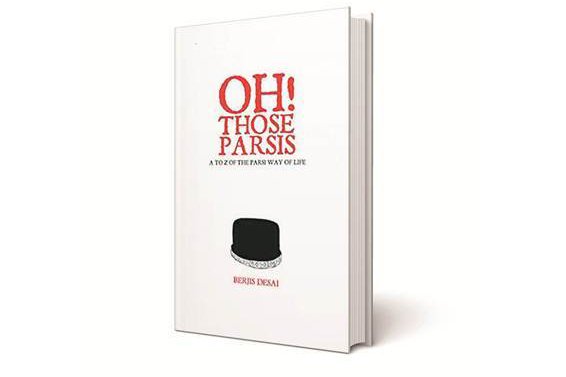Keep Calm and Humour On
The hoi polloi he dubs as the “masoor paavs”, those who gobble their masoor dal with smelly cut onions and suck the marrow from bones using their hands, rather than an elegant marrow spoon.
Book: Oh! Those Parsis: A to Z of the Parsi Way of Life
Author: Berjis Desai
Publishing: ZERO DEGREE PUBLISHING
Pages: 292 pages
Price: 500

As a faithful chronicler of his community, Berjis Desai’s name is familiar to most Parsis. His articles, laced with subtle wit, wisdom and affection, offer deep insight into Parsipanu, the Parsi way of life, which is rapidly disappearing. Along with nostalgic reminiscences and juicy anecdotes bordering on the bawdy, Desai also introspects on where the community is heading today. There are stray but sly references to trustees of the Bombay Parsi Panchayat hurling chairs and tables at each other and the orthodox resorting to physical force to evict outsiders attempting to enter their closed club.
Desai, a leading lawyer and former managing partner at one of India’s major law firms, has diverse interests, including thoroughbred horse breeding and the study of Zoroastrianism and comparative religion. But apart from all his other activities, he is committed to holding up a mirror to his feisty community, replete with its idiosyncrasies and distinctive mores. This book is a compilation of the pieces he penned for the respected English magazine Parsiana, the house journal of the community, between 2014 and 2017.
Several of Desai’s allusions will come as an eye-opener to non-Parsis, even those who live in Mumbai and claim to know the community well. For instance, frequent diners at Parsi restaurants, weddings and navjots may be familiar with such standard delicacies as dhansak and lagan nu custard, but they are unlikely to have sampled the exotic fare which forms part of Parsi temple cuisine, such as malido papri, or Parsi rural cuisine, robust and Spartan, where no part of a bird, animal or overripe fruit is wasted. Such magnificent dishes as oomberioo, (vegetables cooked overnight in a clay pot in the using a charcoal fire) aambakalyo (made of overripe mangoes and tons of sugar), sooka boomla no patio (dried Bombay duck), bhoojan (barbecued goat liver, kidneys and testicles) and garab (roe) are dishes which even I, as a Parsi, have tasted seldom in recent years.
Desai wryly lumps the Parsis of Mumbai into two broad categories. He refers to the elite, tongue-in-cheek, as the NCPA Parsis, who religiously attend every Western music concert at the Tata-funded National Centre for Performing Arts and wince noticeably when anyone is crass enough to clap in the middle of a movement. Their tastes in culture and food tend to be highly Anglicised, and, usually, they do not appreciate Indian classical music.
The hoi polloi he dubs as the “masoor paavs”, those who gobble their masoor dal with smelly cut onions and suck the marrow from bones using their hands, rather than an elegant marrow spoon. Their musical tastes tend to Asha Bhonsle and Kishore Kumar. Desai’s theory is that the social divide in the community is related to when the family migrated to Mumbai from Gujarat. The early migrants were richer, spoke better English, went to the best English schools, had residences in the posher parts of the city and were connected to well-known business families. The later migrants took up professions and became doctors, lawyers, engineers and architects, or were employed by the big Parsi business houses like the Tatas and the Godrejes.
The highly progressive community is known for its bonhomie and joie de vivre, graciousness, and fabled sense of humour. Parsi philanthropy is legendary. But not all Parsis are wealthy, as outsiders generally assume. There are Parsi farmers in far-flung villages in Gujarat living in debt and penury, the long-retired who have run out of savings, but are too self-respecting to seek help, widows in sanatoria making do with one meal a day.
The community’s many charities do not always reach the deserving, though all Parsis have a natural instinct to try to look after their own. There is also, as Desai points out, a xenophobic streak — a strict closed-door policy towards non- Parsis in matters of religion and a gender bias against women who marry outside the faith. Nearly 31 per cent of the community is aged over 65, as compared to the national average of 7 per cent. The population in Mumbai is down to around 37,000. But Parsis generally aren’t bothered about being dubbed a dying race. Their attitude, says Desai, is, “Why worry when you won’t even be there?’’
Desai takes digs at the eccentricities of his co-religionists, but without malice and with the fond familiarity of a fellow traveller. He jokes about the Parsi partiality for milky-white complexions; the domineering Parsi alpha female who often ends up raising a Mama’s boy who doesn’t ever want to leave the maternal nest; the obsessive sense of hygiene; drawing rooms filled with enormous, ornate carved furniture, even if the family has lost all its fortunes and is struggling to make ends meet. Swear words pepper every sentence, which are really terms of endearment. Indeed, life would be too drab without a dash of Parsi idiosyncracy.





